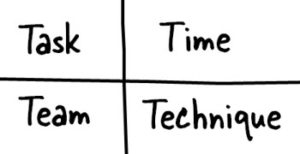In his new best-seller, Drive: The Surprising Truth About What Motivates Us, author Daniel Pink teaches us that everything we think we know about what motivates us is wrong. He makes his case for business and education, but it’s clear that his ideas are a great fit for life in project-based organizations.
 Pink describes a core concept of motivation called the four T’s; simply put, people want autonomy over their Tasks, their Time, their Team, and their Technique. When you take this autonomy away, you pay a big price.
Pink describes a core concept of motivation called the four T’s; simply put, people want autonomy over their Tasks, their Time, their Team, and their Technique. When you take this autonomy away, you pay a big price.
Limiting the four T’s results in the erosion of the most precious asset an organization has: intrinsic motivation. So if you want maximum motivation, then Pink says we have to give people autonomy over their 21st century tasks.
 But how do we do that? Well, the answer is not control through carrots and sticks as 20th century wisdom would suggest. Incentives and disincentives have been proven to do more harm than good. I assert that there is no nastier (or misused) stick in a manager’s arsenal than the bad schedule. How many times have people been beaten up by a schedule that had no basis in reality? Bad schedules make for bad social contracts. Honestly, who is motivated by a schedule they don’t believe in or have some ownership in? How many pathological countermeasures have teams taken to avoid the implications of unrealistic planning? The answers to those questions are “no one” and “many”. Yet, as obvious as those questions are, the bad practices continue.
But how do we do that? Well, the answer is not control through carrots and sticks as 20th century wisdom would suggest. Incentives and disincentives have been proven to do more harm than good. I assert that there is no nastier (or misused) stick in a manager’s arsenal than the bad schedule. How many times have people been beaten up by a schedule that had no basis in reality? Bad schedules make for bad social contracts. Honestly, who is motivated by a schedule they don’t believe in or have some ownership in? How many pathological countermeasures have teams taken to avoid the implications of unrealistic planning? The answers to those questions are “no one” and “many”. Yet, as obvious as those questions are, the bad practices continue.
Ergo, this is THE crisis in project management. Classic project management is not realistic, not social, not complete, and not motivating. The situation seriously cramps productivity and innovation in organizations and it’s in nobody’s best interest to continue this way. Yet management and teams linger at a stalemate because they are locked into the old ways.
The Social Project Management movement is attempting to fix this by standing on the shoulders of social design pioneers such as Facebook, Twitter, and Wikipedia. We now know that it’s possible to make project life more efficient, more effective, and more fun.
The Five Laws of Social Project Management
Transformation of old standards requires fresh thinking and new principles. Here are the laws we are following as we evolve LiquidPlanner.com:
Law #1: Collaboration and projects are inseparable.
Projects are the way organizations get things done. A project embodies goals, objectives, deliverables, resources, plans, promises, and purpose. Chatter and content that is independent from projects is, frankly, just entertainment. If it were otherwise, all we’d need is the Facebook Corporate Edition and we’d be set. Social features on their own have no structure and no direction.
Law #2: Every participant must benefit from participating.
Classic project management creates value for managers but not team members. “What’s in it for me?” must be answerable for every member of the team to achieve real engagement with the process and tools. Think Facebook meets Project Management.
Law #3: Transparency must be maximized.
You hired smart people; don’t overly narrow their focus by limiting their possibilities to communicate and connect ideas. Transparency will create more motivation, more engagement, and more innovation. This is why a web solution is a no brainer: people want to be connected. No need to stop at team members; extending collaboration and transparency to clients, partners, and contractors is just as smart.
Law #4: Autonomy must be maximized.
Delivering autonomy will be the biggest benefit for team members. Put as much ownership of data, estimates, and control as possible into team members’ hands. Then, intelligently aggregate information for managers. Trust people to make smart contributions, but keep a public audit trail for accountability (think Wikipedia).
Law #5: Estimating and scheduling must be realistic.
Honesty, integrity, and trust are pillars of organizational character. But when we build and enforce bad schedules, we erode all three at great expense to the organization. Any realistic schedule requires dealing with the realities of uncertainty, balancing workloads, and making justifiable promises. For 21st century projects, this requires a good real-time scheduling engine, preferably one that uses ranged-estimates to manage uncertainty.
Conclusion
The tough economy is giving us the perfect excuse to remodel the way we work with self-direction as a core principle.
Pink describes a “Results Only Work Environment;” this seems like a future we’d all like to be a part of. We can accelerate this change by insisting that our project management tools evolve to fit the way we work instead of the other way around.
I know I’ve changed. How about you?
About the Author
Charles Seybold is the CEO of LiquidPlanner.com, a leading provider of online project management tools. LiquidPlanner blends innovative scheduling with rich collaboration tools to create a new way so the whole team can work together to get more projects done with less effort.
 Schedule a demo of LiquidPlanner with a product expert today
Schedule a demo of LiquidPlanner with a product expert today







